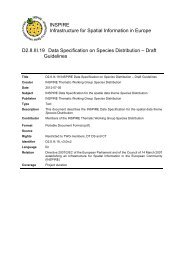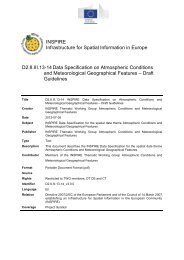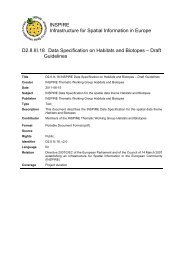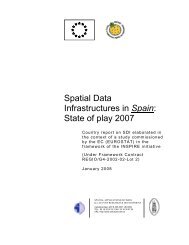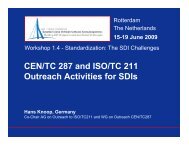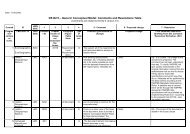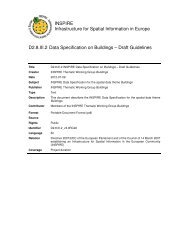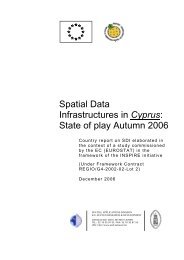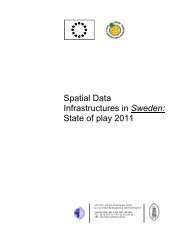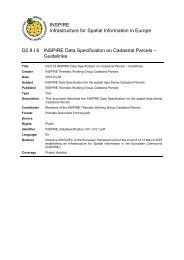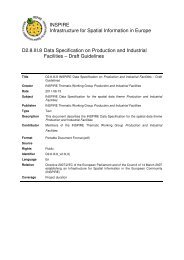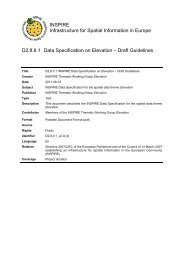Data Specification on Orthoimagery – Draft ... - INSPIRE - Europa
Data Specification on Orthoimagery – Draft ... - INSPIRE - Europa
Data Specification on Orthoimagery – Draft ... - INSPIRE - Europa
You also want an ePaper? Increase the reach of your titles
YUMPU automatically turns print PDFs into web optimized ePapers that Google loves.
<strong>INSPIRE</strong> Reference: D2.8.II.3_v2.0<br />
TWG-OI <str<strong>on</strong>g>Data</str<strong>on</strong>g> <str<strong>on</strong>g>Specificati<strong>on</strong></str<strong>on</strong>g> <strong>on</strong> <strong>Orthoimagery</strong> 2011-06-15 Page 56<br />
Annex C<br />
(normative)<br />
Pan-European Grid for raster <strong>Orthoimagery</strong> data at global level<br />
This annex explains the need to establish a comm<strong>on</strong> European grid to provide raster-based spatial<br />
informati<strong>on</strong> for the <strong>Orthoimagery</strong> theme aimed at Pan-European global purposes within the <strong>INSPIRE</strong><br />
c<strong>on</strong>text and establishes the characteristics of this grid.<br />
This grid is harm<strong>on</strong>ised with other themes with similar needs.<br />
C.1 Introducti<strong>on</strong><br />
The amount of informati<strong>on</strong> made available to users will be enormous when <strong>INSPIRE</strong> services become<br />
operative. In order to combine all these data sets or make cross-reference analyses aimed at<br />
satisfying pan-European cross-border needs, it would be highly desirable to make data available in the<br />
same coordinate reference system (with its associated datum) to obtain c<strong>on</strong>sistent data. This is<br />
supported by key use-cases like flood modelling and emergency resp<strong>on</strong>se.<br />
C<strong>on</strong>servati<strong>on</strong> of original radiometric values is important when working with raster files, since<br />
interpolati<strong>on</strong>s directly affect the accuracy of those variables computed from them. As an example, in<br />
the case of elevati<strong>on</strong>s resampling diminishes height values associated to points <strong>on</strong> the Earth surface.<br />
The different projecti<strong>on</strong>s allowed by the <strong>INSPIRE</strong> <str<strong>on</strong>g>Data</str<strong>on</strong>g> <str<strong>on</strong>g>Specificati<strong>on</strong></str<strong>on</strong>g> <strong>on</strong> Coordinate Reference<br />
Systems v3.1 for representati<strong>on</strong> in plane coordinates are recommended in associati<strong>on</strong> to a certain<br />
range of scales and/or purposes, but problems arise when combining the data using these map<br />
projecti<strong>on</strong>s (due to their inherent characteristics). As an example, ETRS-LAEA is suitable for spatial<br />
analysis and reporting, ETRS89-LCC is recommended for mapping at scales smaller than 1:500,000<br />
and ETRS89-TMzn at scales greater than 1:500,000, with the additi<strong>on</strong>al inc<strong>on</strong>venient of using different<br />
z<strong>on</strong>es for the whole Europe.<br />
Hence, it would be recommendable to minimise coordinate reference system transformati<strong>on</strong>s of the<br />
data sets as possible, in order to preserve quality.<br />
Furthermore, even in the case data is made available in the same coordinate reference system, when<br />
combining raster georeferenced data from different sources, limits of grid cells or pixels usually do not<br />
match in x, y coordinates (i.e. may be they are not aligned due to the fact they were generated by<br />
independent producti<strong>on</strong> chains). In order to get the proper alignment of grid cells or pixels it is<br />
necessary to establish additi<strong>on</strong>al rules, such as the origin of the comm<strong>on</strong> grid and the reference point<br />
of a grid cell.<br />
Secti<strong>on</strong> 2.2.1 of the Commissi<strong>on</strong> Regulati<strong>on</strong> (EU) No 1089/2010, <strong>on</strong> interoperability of spatial data<br />
sets and services, establishes a comm<strong>on</strong> grid for pan-European spatial analysis and reporting. This<br />
geographical grid (identified as Grid_ETRS89-LAEA) is based <strong>on</strong> the ETRS89 Lambert Azimuthal<br />
Equal Area coordinate reference system (ETRS89-LAEA) and is proposed as the multipurpose Pan-<br />
European standard. However, the Grid_ETRS89-LAEA is not suited for <strong>Orthoimagery</strong> data:<br />
• LAEA projecti<strong>on</strong> is inappropriate for the <strong>Orthoimagery</strong> theme data due to its inherent properties:<br />
- The directi<strong>on</strong> of the Geographic North varies as geographical l<strong>on</strong>gitude does;<br />
- The scale gradually decreases from the centre of the projecti<strong>on</strong>;<br />
- Directi<strong>on</strong>s are <strong>on</strong>ly true directi<strong>on</strong>s from this point;<br />
- Shape distorti<strong>on</strong>s increases while moving away from this point.<br />
- It makes difficult the use of hierarchical levels of grid cell sizes, since resoluti<strong>on</strong> varies<br />
depending <strong>on</strong> the positi<strong>on</strong>;




